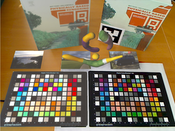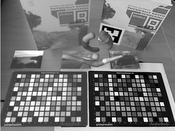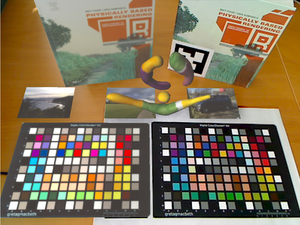Information
- Publication Type: Conference Paper
- Workgroup(s)/Project(s):
- Date: October 2011
- ISBN: 978-1-4577-2183-0
- Publisher: IEEE/IET Electronic Library (IEL), IEEE-Wiley eBooks Library, VDE VERLAG Conference Proceedings
- Note: E-ISBN: 978-1-4577-2184-7
- Location: Basel, Switzerland
- Booktitle: Proceedings of the 2011 IEEE International Symposium on Mixed and Augmented Reality (ISMAR 2011)
- Conference date: 26. October 2011 – 29. October 2011
- Pages: 165 – 168
- Keywords: Color Matching, Differential Rendering, Mixed Reality, Tone Mapping
Abstract
We present a novel adaptive color mapping method for virtual objects in mixed-reality environments. In several mixed-reality applications, added virtual objects should be visually indistinguishable from real objects. Recent mixed-reality methods use global-illumination algorithms to approach this goal. However, simulating the light distribution is not enough for visually plausible images. Since the observing camera has its very own transfer function from real-world radiance values to RGB colors, virtual objects look artificial just because their rendered colors do not match with those of the camera.Our approach combines an on-line camera characterization method with a heuristic to map colors of virtual objects to colors as they would be seen by the observing camera. Previous tone-mapping functions were not designed for use in mixed-reality systems and thus did not take the camera-specific behavior into account. In contrast, our method takes the camera into account and thus can also handle changes of its parameters during runtime. The results show that virtual objects look visually more plausible than by just applying tone-mapping operators.
Additional Files and Images
Additional images and videos
 Image 1:
Shows color adaption of virtual book and colorchart on the left
Image 1:
Shows color adaption of virtual book and colorchart on the left
 Image:
Shows color adaption of virtual book and colorchart on the left
Image:
Shows color adaption of virtual book and colorchart on the left
 Video:
Video results
Video:
Video results
Additional files
 Preprint:
Conference Paper
Preprint:
Conference Paper
Weblinks
No further information available.BibTeX
@inproceedings{knecht-2011-CBCM,
title = "Adaptive Camera-Based Color Mapping For Mixed-Reality
Applications",
author = "Martin Knecht and Christoph Traxler and Werner Purgathofer
and Michael Wimmer",
year = "2011",
abstract = "We present a novel adaptive color mapping method for virtual
objects in mixed-reality environments. In several
mixed-reality applications, added virtual objects should be
visually indistinguishable from real objects. Recent
mixed-reality methods use global-illumination algorithms to
approach this goal. However, simulating the light
distribution is not enough for visually plausible images.
Since the observing camera has its very own transfer
function from real-world radiance values to RGB colors,
virtual objects look artificial just because their rendered
colors do not match with those of the camera. Our approach
combines an on-line camera characterization method with a
heuristic to map colors of virtual objects to colors as they
would be seen by the observing camera. Previous tone-mapping
functions were not designed for use in mixed-reality systems
and thus did not take the camera-specific behavior into
account. In contrast, our method takes the camera into
account and thus can also handle changes of its parameters
during runtime. The results show that virtual objects look
visually more plausible than by just applying tone-mapping
operators.",
month = oct,
isbn = "978-1-4577-2183-0 ",
publisher = "IEEE/IET Electronic Library (IEL), IEEE-Wiley eBooks
Library, VDE VERLAG Conference Proceedings",
note = "E-ISBN: 978-1-4577-2184-7",
location = "Basel, Switzerland",
booktitle = "Proceedings of the 2011 IEEE International Symposium on
Mixed and Augmented Reality (ISMAR 2011)",
pages = "165--168",
keywords = "Color Matching, Differential Rendering, Mixed Reality, Tone
Mapping",
URL = "https://www.cg.tuwien.ac.at/research/publications/2011/knecht-2011-CBCM/",
}


 Preprint
Preprint Video
Video